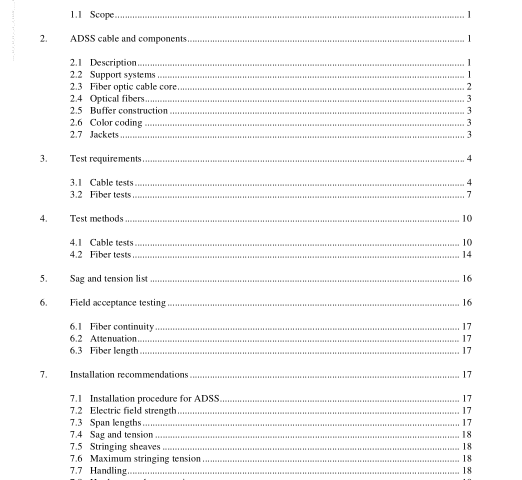IEEE 1222-2011 pdf download.IEEE Standard for All-Dielectric Self-Supporting Fiber Optic Cable
2.3 Fiber optic cable core
The fiber optic cable core shall be made up of coated glass optical fibers housed to protect the fibers from mechanical, environmental, and electrical stresses. Materials used within the core shall be compatible with one another, shall not degrade under the electrical stresses to which they may be exposed, and shall not evolve hydrogen sufficient to degrade optical performance of fibers within the cable.
2.3.1 Fiber strain allowance
The cable core shall be designed such that fiber strain does not exceed the limit allowed by the cable manu- facturer under the operational design limits of the cable. Maximum allowable fiber strain will generally be a function of the proof test level and strength and fatigue parameters of the coated glass fiber.
2.3.2 Central structural element
If a central structural element is necessary, it shall be of reinforced plastic, epoxiglass, or other dielectric material. If required, this element shall provide the necessary tensile strength to limit axial stress on the fibers and minimize fiber buckling due to cable contraction at low temperatures.
2.3.3 Buffer tube filling compound Loose buffer tubes shall be filled with a suitable compound compatible with the tubing material, fiber coat- ing, and coloring to protect the optical fibers and prevent moisture ingress.
2.3.4 Cable core filling/flooding compound
The design of the cable may include a suitable filling/flooding compound in the interstices to prohibit water migration along the fiber optic cable core. The filling compound shall be compatible with all components with which it may come in contact.
2.3.5 Binder/tape
A binder yarn(s) and/or a layer(s) of overlapping nonhygroscopic tape(s) may be used to hold the cable core elements in place during application of the jacket.
2.3.6 Inner jacket A protective inner jacket or jackets of a suitable material may be applied over the fiber optic cable core, iso- lating the cable core from any external strength elements and the cable outer jacket.
2.4 Optical fibers
Single-mode fibers, dispersion-unshifted, dispersion-shifted, or nonzero dispersion-shifted, and multimode fibers with 50/125 mm or 62.5/125 mm core/clad diameters are considered in this standard. The core and the cladding shall consist of glass that is predominantly silica (SiO2). The coating, usually made from one or more plastic materials or compositions, shall be provided to protect the fiber during manufacture, handling, and use.
2.5 Buffer construction
The individually coated optical fiber(s) or fiber ribbon(s) may be surrounded by a buffer for protection from physical damage during fabrication, installation, and performance of the ADSS. Loose buffer or tight buffer construction are two types of protection that may be used to isolate the fibers. The fiber coating and buffer shall be strippable for splicing and termination.
2.5.1 Loose buffer Loose buffer construction shall consist of a tube or channel that surrounds each fiber or fiber group. The inside of the tube or channel shall be filled with a filling compound.
2.5.2 Tight buffer construction
Tight buffer construction shall consist of a suitable material that comes in contact with the coated fiber.
2.6 Color coding
Color coding is essential for identifying individual optical fibers and groups of optical fibers. The colors shall be in accordance with TIA/EIA 598-A-1995 [B43]. 1 2.6.1 Color performance The original color coding system shall be discernible and permanent, in accordance with EIA 359-A- 1985 [B3], throughout the design life of the cable, when cleaned and prepared per manufacturer’s recommendations.
2.7 Jackets
The outer jacket shall be designed to house and protect the inner elements of the cable from damage due to moisture, sunlight, environmental, thermal, mechanical, and electrical stresses.
a) The jacket material shall be dielectric, non-nutrient to fungus, and meet the requirements of 3.1.1.13. The jacket material may consist of a polyethylene that shall contain carbon black and an antioxidant.
b) The jacket shall be extruded over the underlying element and shall be of uniform diameter to prop- erly fit support hardware. The extruded surface shall be smooth for minimal ice buildup.IEEE 1222 pdf download.IEEE 1222-2011 pdf download
IEEE 1222-2011 pdf download

Leave a Reply